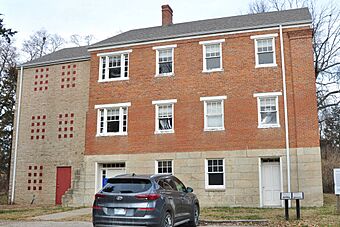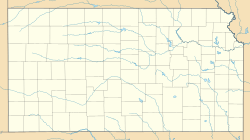- This page was last modified on 17 October 2025, at 10:18. Suggest an edit.
Iowa and Sac & Fox Mission State Historic Site facts for kids
|
Iowa, Sac, and Fox Presbyterian Mission
|
|
 |
|
| Location | 1737 Elgin Rd., near Highland, Kansas |
|---|---|
| Area | 9.9 acres (4.0 ha) |
| Built | 1846 |
| NRHP reference No. | 70000248 |
| Added to NRHP | December 2, 1970 |
The Iowa and Sac & Fox Mission State Historic Site is a special place in Highland, Kansas. It's also known as the Highland Presbyterian Mission. This site was once a mission where children from the Iowa and Sac & Fox tribes lived and learned. It operated from 1845 to 1863.
The main building at the site is very old and important. It was added to the National Register of Historic Places in 1970. This means it's recognized as a significant historical landmark.
The building has had different uses over the years. It was a museum from 1996 to 2008, showing Native American arts. It then reopened as a museum in 2022.
Contents
The Historic Mission Building
The mission building is a large, three-story structure made of stone and brick. It has a tall belfry on top, making it about 52 feet (16 m) high. The building is about 106 by 37 feet (32 m × 11 m) in size.
It was built in 1846 to replace an older building. This new building served as both a church and a school for the Native American children in the area. It became part of the National Register of Historic Places in 1970.
A Look Back: Mission History
The story of the mission begins in 1836. William Clark, who was in charge of Native American affairs, made a treaty with the Iowa people and the Sac and Fox Nation of Missouri in Kansas and Nebraska. In this agreement, the tribes gave up their land from Missouri to the Missouri River for $7,500. In return, the government promised to build five homes and provide goods and services.
As the tribes moved to their new lands, missionaries saw a chance to share their Christian beliefs. They decided to set up a mission, which they called "The Ioway and Sac Mission."
Starting the Mission
A Presbyterian mission was started in 1837. It was about two miles (3.2 km) from where Highland, Kansas is today. Samuel M. Irvin and his wife began the mission, and later Reverend William Hamilton joined them.
Mr. Irvin was sent by the Presbyterian Board of Missions. His goal was to create a farming mission for the Iowa and Sac & Fox people, who traditionally hunted for food. Irvin tried to teach the tribes how to raise animals and farm. When this didn't work well, the mission board changed its plan. They decided to teach younger children, hoping to help them learn new ways of life.
Building the Permanent Structure
The first mission building was a simple one-story log cabin. But in 1844, the Presbyterian board approved a permanent building. This new structure was finished by July 1846.
The completed building was three stories tall and included a belfry, reaching a total height of 52 feet (16 m). It was 107 feet (33 m) long and 37 feet (11 m) wide. The building was made from limestone and bricks that were created right there on the site. It had 32 rooms, including a dining hall and a chapel.
Learning and Printing at the Mission
Samuel Irvin asked the missionary board for a printing press. He wanted to print books and religious texts in the Iowa language. The press was approved and arrived at the mission in 1843.
Lessons were taught in both English and the Iowa language. Students studied spelling, Arithmetic, and geography. They also learned practical skills like industrial work, homemaking, and farming.
Irvin and Hamilton printed several books in the Iowa language to help with learning. These included An Elementary Book of the Ioway Language and a religious book called Original Hymns in the Ioway Language. They even had to create a special writing system, called a Syllabary, for the Iowa language to translate and print these books.
They included a small note in their books, explaining that any mistakes in the printing were because they were new to it. They wrote that their printing experience was gained "entirely in the Indian country, and without any instructor." The mission produced nine different titles and was the second place in Kansas to have a printing press.
Daily Life and Challenges
The main goal of the mission was to encourage the tribes to adopt Christian beliefs and become self-sufficient farmers. On average, about 40 students lived at the mission. A typical day started at 5 AM. Students had six hours of school starting at 9 AM. All other non-school hours were spent working under Mr. Irvin's guidance. Girls were taught homemaking and housekeeping skills by Mrs. Eliza Irvin.
From the early 1840s until 1965, the Oregon Trail was a busy route. The mission was a useful stop along the trail. The tribes earned money by charging a toll to cross their bridge. However, travelers also brought diseases like smallpox and cholera. These diseases caused serious outbreaks, leading many tribal members to move away from the mission.
The Mission's Closure and New Life
The Kansas–Nebraska Act of 1854 further reduced the size of Native American reservations. This made the distance between the mission and the reservations much greater. It became too difficult for tribal children to attend, and so the mission closed in 1863. In 1856, the mission had 44 students.
After closing as a mission, the building became an orphanage from 1863 to 1866. It then sat empty for two years. From 1866 to 1868, the western part of the building was taken down to create a dormitory. This left only about 40 percent of the original structure.
Preservation and Reopening
The Northeast Kansas Historical Society decided to save the remaining part of the building. It had been used as a private home from 1905 to 1937. In 1941, the state bought the property. It was officially declared a state historical site in 1963. The building was added to the National Register of Historic Places in 1970.
In 1996, the museum was updated and reopened to display Native American arts. It closed again in 2008.
In 2021, the state gave control of the property to the Iowa Tribe of Kansas. It became part of the Ioway Tribal National Park. The museum reopened in 2022.
The site is located about 1.5 miles (2.4 km) east of Highland on 240th Road, then .2 miles (0.32 km) north on Elgin Road.


